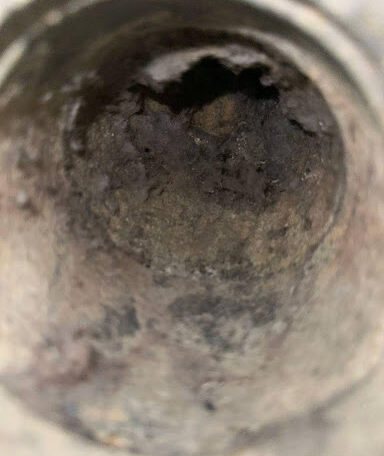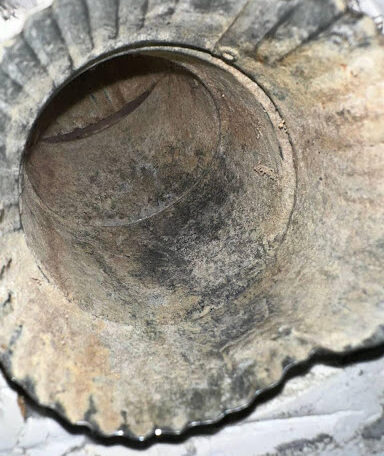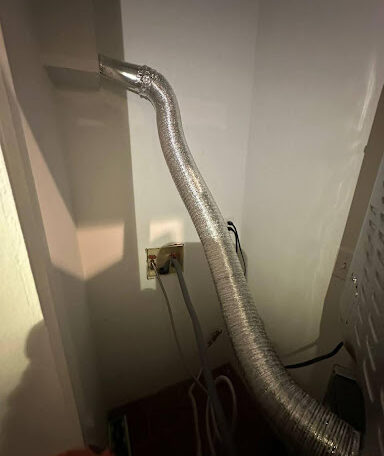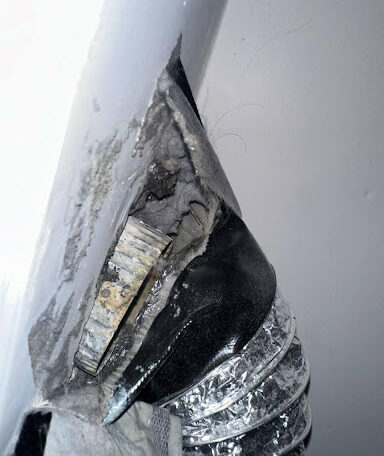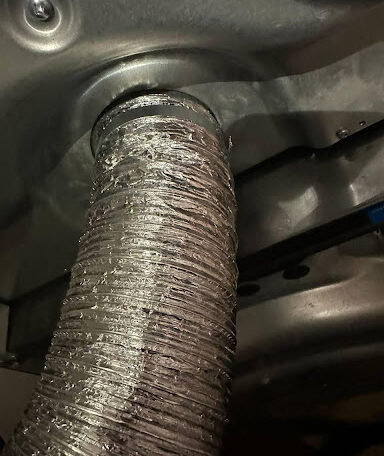We’ve already talked about flexible ducts in dryer vents and why they are dangerous in one of our posts, you can read it here.
In today’s story flexible ducting is just a part of the problem. Our technicians found it together with 3-inch pipes comprising a dryer vent. That’s a very serious fire hazard that mustn’t be left unsolved.
You see, these are the rules that domestic dryer setups must follow, as outlined in the Mechanical Code of New York State:
“504.8.1 Material and size. Exhaust ducts shall have a
smooth interior finish and shall be constructed of metal
not less than 0.016 inch (0.4 mm) in thickness. The
exhaust duct size shall be 4 inches (102 mm) nominal in
diameter.”
Obviously, neither the flexible ducts nor 3-inch pipes comply with these requirements; they represent real fire hazards that could jeopardize the safety of the entire household. Let’s see how the hazards were discovered and what our technicians advised the homeowners.
How It All Began
A few weeks ago, homeowners in Brooklyn started to notice that their dryer was taking longer to dry clothes, and the air around the appliance felt unusually warm. Concerned about the potential fire hazard, they decided it was time for a professional dryer vent cleaning and inspection. After all, safety should always come first.
The Inspection and Cleaning Process
The clients called in the MainDuct team of experts for their dryer vent maintenance. We conducted a thorough cleaning using specialized brushes and vacuum equipment designed to remove lint and debris that had accumulated over time. This meticulous process not only ensured that the dryer would operate more efficiently but also significantly reduced the risk of a fire—an essential consideration for any homeowner.
However, as our technicians delved deeper, they uncovered additional issues that needed addressing.
Transition Hose Replacement
While inspecting the system, the technicians discovered that the transition hose connecting the dryer to the vent was outdated and not up to code. To remedy this, they replaced it with a UL LISTED and labeled transition hose, ensuring compliance with the NY Mechanical Codes. They also crafted a 3-inch to 4-inch adapter, guaranteeing a safe and secure connection for the new hose.
The client’s system became much safer with the transition hose replaced and the dryer vent cleaned. Although, some problems still required solutions.
Additional Challenges Remain
Cleaned vent and replaced transition hose are a great beginning to ensure safety in this particular household. However, our engineers have discovered a network of 3-inch pipes running through the walls, a setup that not only violates building codes but also poses a significant fire hazard. And a view from the roof uncovered a flexible duct, hinting at even more complications lurking in the shadows.
This situation is more than just a technical oversight; it’s a ticking time bomb. The use of such small pipes is a serious code violation, and the presence of flexible ducting only intensifies the risk. Homeowners might be tempted to overlook these issues, but ignoring them could lead to catastrophic consequences.
To remedy this dangerous scenario, the best course of action is clear: replace the existing line. This is not just about compliance with safety codes; it’s about ensuring safety for everyone in the building.
The Plan for Line Replacement
Vent line replacement that we proposed is an opportunity for a fresh start. The replacement work is estimated to take about 2 to 3 days.
Before any work begins, a camera inspection will be conducted to assess the situation accurately. This step is crucial, as it will provide a precise quote based on the actual conditions hidden within the walls.
The plan involves running a new line through the apartment and into the nearest wall, ensuring that the new installation meets safety standards. During the replacement process, we’ll cover the work area to contain dust and debris, safeguarding the living space from unnecessary mess.
Once the new line is in place, the first layer of putty will be applied, sealing the work done.
Throughout this project, every step taken and proposed is a step towards safety and code compliance. The walls may have concealed dangers, but with the right actions, they can also become a testament to resilience and proactive care. Replacing the line will bring the utmost safety to the system setup.
Extra Reading About Dryer Vents
You can read more about dryer vent maintenance in our series of posts. We explored essential tips for keeping your dryer vent in good condition between professional cleanings, discussed how often you should schedule those services, highlighted the fire risks associated with dirty dryer vents, and examined how neglecting your dryer vent could affect your insurance premiums.We also talked about the importance of proper dryer vent covers.
